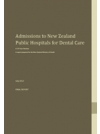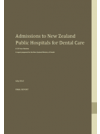This report, commissioned by the Ministry of Health, looks at the ages, sex, ethnicity and deprivation level of people admitted to hospital for dental care. Data was obtained primarily from the national data held by the Ministry for the 20-year period between 1990 and 2009.
Key Results
The report found that:
- the national rate of hospital admissions for dental care has increased nearly four-fold, from 0.76 per 1000 of population in 1990 to 3 per 1000 in 2009
- children under the age of eight had the highest rates of admissionthere was significant regional variation between district health boards (DHBs)
- rates of admission are higher for Māori and Pacific peoples, and those living in areas of the highest deprivation, than for the population in general
- for people aged 18 years and over, 61 percent had an additional condition or co-morbidity
- around 10 percent of dental admissions to hospital are acutethe majority of admissions were for dental disease, and the most common treatments were tooth extractions and fillings
- admissions for dental and/or maxillofacial injuries almost trebled between 1990 and 2009
- most dental admissions are now day-stays.
- Overnight stays reduced from 46 to 12 percent between 1990 and 2005.
- These findings are in line with international trends.
In New Zealand, factors influencing the increase in hospital dental admissions include:
- safer anaesthetic practices that increase the need for general anaesthetic to be provided in hospitals rather than in private dental practices
- variable use of primary dental care services
- inconsistent access to fluoridated water
- lack of primary prevention activity, ie, twice daily tooth brushing with fluoride toothpaste
- high and increasing levels of disease in some population groups
- increasing numbers of older people keeping their natural teeth and needing complex treatments.
The report provides useful data to help service planners, policy makers and researchers.


